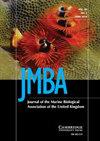地中海东部的海洋双壳类凭证 DNA 条形码,以及 Ostrea stentina 入侵的证据
IF 0.9
4区 生物学
Q3 MARINE & FRESHWATER BIOLOGY
Journal of the Marine Biological Association of the United Kingdom
Pub Date : 2024-04-22
DOI:10.1017/s0025315424000377
引用次数: 0
摘要
双壳类软体动物种类繁多,具有特殊的经济和生态重要性。它们的形态特征经常会混淆识别,导致可食用物种的错误标记。面对海洋酸化和变暖等环境压力,遗传多样性对海洋双壳类种群的恢复能力至关重要。在这项研究中,我们描述了六种海洋双壳类动物(Ostrea edulis (Linnaeus, 1758) Arca noae (Linnaeus, 1758)、Pinctada radiata (Leach, 1814)、Venus verrucosa (Linnaeus, 1758)、利用细胞色素 c 氧化酶亚单位 I(COI)和 18S 核糖体 RNA(18S rRNA)作为分子标记,对爱琴海和爱奥尼亚海不同沿海地区采样的[Calllista chione(Linnaeus,1758)和 Ruditapes decussatus(Linnaeus,1758)]进行了分析。此外,由于 18S rRNA 没有表现出同种差异,因此使用 COI 基因来研究种群遗传多样性。18S rRNA 序列成功地在科或超科水平上区分了双壳类动物,但偶尔被证明不足以进行物种鉴定。相反,COI 的信息量很大,能可靠地区分所有物种。种群单倍型多样性为中等至高等,核苷酸多样性通常较低,这表明单倍型在遗传上密切相关。我们发现,即使在遥远的取样区域,入侵的 Pinctada radiata 也是泛种群,而 Ostrea edulis 是唯一表现出中等程度种群细分的物种。最后,我们在此首次报告了在 Thermaikos 海湾采样的 Ostrea edulis 标本中发现了 Ostrea stentina,这表明地中海东部出现了一种新的双壳类入侵物种。本文章由计算机程序翻译,如有差异,请以英文原文为准。
Marine bivalves voucher DNA barcoding from Eastern Mediterranean, with evidence for Ostrea stentina invasion
Bivalve molluscs are a diverse group of animals with particular economic and ecological importance. Their morphological characteristics frequently confuse their identification leading to mislabelling of edible species. Genetic diversity is critical to the resilience of marine bivalve populations in the face of environmental stressors such as ocean acidification and warming. In this study, we characterized the phylogeny and defined the first DNA barcodes of six marine bivalves [Ostrea edulis (Linnaeus, 1758) Arca noae (Linnaeus, 1758), Pinctada radiata (Leach, 1814), Venus verrucosa (Linnaeus, 1758), Calllista chione (Linnaeus, 1758) and Ruditapes decussatus (Linnaeus, 1758)] sampled from different coastal areas of Aegean and Ionian Seas using the molecular markers cytochrome c oxidase subunit I (COI) and 18S ribosomal RNA (18S rRNA). Further, COI gene was employed to investigate the population genetic diversity since 18S rRNA exhibited no conspecific differences. The sequence of 18S rRNA successfully discriminated the bivalves at family or superfamily level but occasionally proved insufficient for species identification. Contrariwise, COI was highly informative and could reliably distinguish all species. Population haplotype diversity was moderate to high and was always accompanied by generally low nucleotide diversity, indicating genetically closely related haplotypes. The invasive Pinctada radiata was found to be panmictic even among distant sampling areas, while Ostrea edulis was the only species that exhibited moderate levels of population subdivision. Finally, here we report for the first time the presence of Ostrea stentina in Thermaikos Gulf sampled among Ostrea edulis specimens, demonstrating a new invasive bivalve species in Eastern Mediterranean.
求助全文
通过发布文献求助,成功后即可免费获取论文全文。
去求助
来源期刊
CiteScore
2.30
自引率
8.30%
发文量
68
审稿时长
3-8 weeks
期刊介绍:
JMBA is an international journal, publishing original research on all aspects of marine biology. It includes pioneering work taking place today on major issues concerning marine organisms and their environment. Subjects covered include: ecological surveys and population studies of marine communities; physiology and experimental biology; taxonomy, morphology and life history of marine animals and plants; and chemical and physical oceanographic work. Included with 2010 online subscriptions: Marine Biodiversity Records.

 求助内容:
求助内容: 应助结果提醒方式:
应助结果提醒方式:


